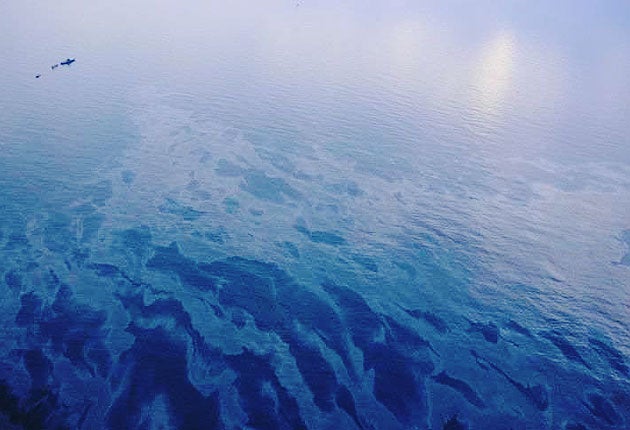Huge oil slick heads for Ireland and Wales

Your support helps us to tell the story
From reproductive rights to climate change to Big Tech, The Independent is on the ground when the story is developing. Whether it's investigating the financials of Elon Musk's pro-Trump PAC or producing our latest documentary, 'The A Word', which shines a light on the American women fighting for reproductive rights, we know how important it is to parse out the facts from the messaging.
At such a critical moment in US history, we need reporters on the ground. Your donation allows us to keep sending journalists to speak to both sides of the story.
The Independent is trusted by Americans across the entire political spectrum. And unlike many other quality news outlets, we choose not to lock Americans out of our reporting and analysis with paywalls. We believe quality journalism should be available to everyone, paid for by those who can afford it.
Your support makes all the difference.The biggest oil slick to threaten Ireland and the UK for more than ten years was tonight being tracked as it moved closer towards coastlines.
The spill, discovered near to where a Russian warship was refuelling in the Celtic Sea, is now believed to be 1000 tonnes - over three times the original estimate - and could reach Irish and Welsh shores in just over two weeks.
The incident in Irish-patrolled waters has sparked a flurry of diplomatic contact between Dublin and Russia, while British authorities have also been drawn into the ongoing investigations.
Environmentalists said it has the potential to devastate marine and wildlife, with knock-on effects on seaside tourism and fishing hot-spots.
A Russian destroyer, a British destroyer, an Irish Naval vessel and a Russian aircraft carrier remain at the scene of the spill about 50 miles south of Fastnet Rock, off the west Cork coast, along with an ocean-going tug and two refuelling tankers.
The Irish government has asked the Russian embassy in Dublin to hand over samples of the oils carried onboard the Russian tankers and aircraft carrier.
While some of the slick - originally covering an area of around 2.8 miles by 3.1 miles - will break up or evaporate, the bulk of it is expected to remain on the surface, and is veering eastwards at around 12 miles a day.
"The residual oil remaining is expected to develop into tar balls," said a spokeswoman for Ireland's Department of Transport.
"Depending on weather conditions these may end up on the Irish south east coast in approximately 16 days time and also impact on the Welsh coastline."
Both the Irish Coast Guard and the UK Coastguard are carrying out aerial surveillance flights, using special sonar equipment, over the area while a tug is being launched from Cork to carry out tests to see if the oil is recoverable at sea.
But authorities believe from past international experience that it is too difficult to contain and capture such a slick.
Friends of the Earth (FoE), the environmental organisation, has described it as a "significant spill" bound to cause serious damage to marine life and has called for a full investigation.
"It's extremely significant at that size. Damage to marine life is likely to be devastating, and this will have, as many environmental things do, economic repercussions," said Molly Walsh, FoE spokeswoman.
Samples of the oil have been taken from the scene for analysis, while Government departments and agencies are being constantly briefed about the potential impact to the environment.
Irish authorities were alerted to the spill on Saturday through a satellite surveillance pollution report by the European Maritime Safety Agency in Lisbon.
The Russian Navy confirmed one its carriers was refuelling at sea from a Russian supply tanker and said it was carrying out its own internal investigation.
The incident happened outside Irish territorial waters, but within an area known as Ireland's Exclusive Economic Zone, which it patrols, according to the Irish Government.
John Lucey, a senior biologist with Ireland's Environmental Protection Agency, said it was the biggest oil spillage in the waters around Ireland for more than 10 years and its impact depends on when it hits our shores.
When the Sea Empress ran aground off Milford Haven in south west Wales, in 1996, shedding 72,000 tonnes, it caused widespread damage to the nearby coastline.
By the time it reached Irish shores, the oil had formed into "tar balls" and had little or no impact.
But a spillage of just 31 tonnes in Cork Harbour a year later proved disastrous for marine and wildlife, particularly birds.
"If it did land here, and if it was two weeks, it could start forming tar balls and not be as potentially dangerous as a big, fresh slick coming onshore as we've had in the past," said Mr Lucey.
"If it's a slick, that's the danger."
Join our commenting forum
Join thought-provoking conversations, follow other Independent readers and see their replies
Comments